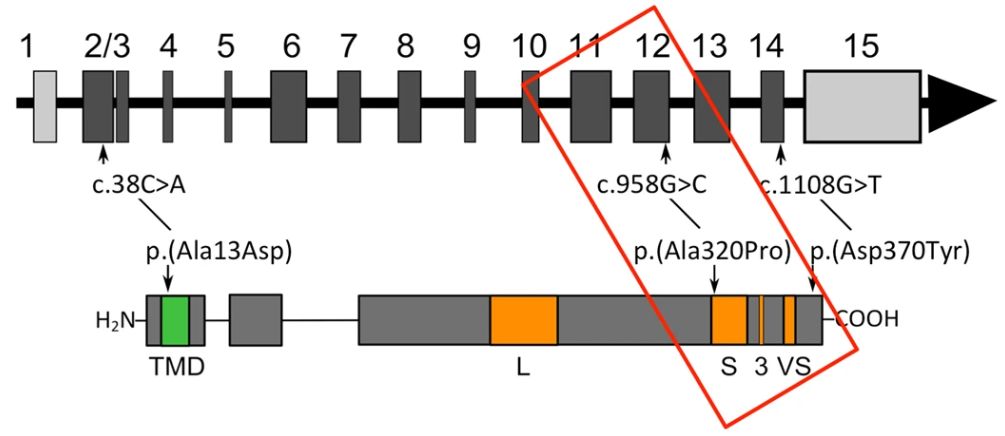What is ST3GAL3 Protein
The ST3GAL3 protein is a member of the sialyltransferase family encoded by the ST3GAL3 gene, which coordinates important functions in the human body.
What is ST3GAL3 Protein?
ST3GAL3, short for Sialyltransferase 3, is an enzymatic maestro that catalyzes the transfer of sialic acid residues to glycoproteins and glycolipids. Sialic acids, being pivotal components of these molecules, confer unique biological properties, and ST3GAL3, as a glycosyltransferase, holds the responsibility for their strategic placement.

Figure 1. ST3GAL3 structure and localization. (van Diepen, L., et al. 2018)
The Function of ST3GAL3 Protein
Central to its role is the biosynthesis of gangliosides, a subclass of glycosphingolipids abundantly found in neural tissues. Gangliosides play a paramount role in neuronal development, signal transduction, and cell adhesion. ST3GAL3, by mediating the addition of sialic acid to glycoproteins, intricately contributes to the complexity and functionality of these neural components.
ST3GAL3-Related Diseases
- Neurological Disorders
The involvement of ST3GAL3 in ganglioside biosynthesis links it to neurological diseases. In Alzheimer's disease and Parkinson's disease, aberrations in ST3GAL3 expression have been observed, suggesting a potential link between disrupted ganglioside metabolism and neurodegeneration.
- Cancer
The spotlight on ST3GAL3 intensifies in the realm of cancer. Its overexpression has been correlated with poor prognosis in various cancer types. This is attributed to its influence on cell adhesion and migration, implicating ST3GAL3 as a potential player in cancer progression and metastasis.
- Immune Disorders
Sialic acids, under the orchestration of ST3GAL3, are critical for immune recognition and response. Changes in ST3GAL3 activity may contribute to autoimmune diseases or immune dysregulation, further emphasizing its far-reaching impact on human health.
ST3GAL3 Related Signaling Pathways
- Ganglioside-Mediated Signaling
ST3GAL3 takes center stage in ganglioside-mediated signaling pathways. Gangliosides, modulated by ST3GAL3, influence cell surface receptor activities, cell adhesion, and intracellular signal transduction. The alterations in ST3GAL3 expression thus have the potential to disrupt these signaling cascades, contributing to disease states.
- Interaction with Other Glycosyltransferases
ST3GAL3 operates in concert with a network of glycosyltransferases, collectively shaping the glycosylation patterns of cellular proteins. The disruption in this intricate network can lead to altered cell surface properties, laying the foundation for disease progression.
- Inflammatory Signaling
The involvement of sialic acids in inflammatory responses ties ST3GAL3 to immune modulation. Changes in ST3GAL3 expression may influence immune cell sialylation, thereby modulating inflammatory signaling pathways and potentially offering avenues for therapeutic intervention in conditions characterized by chronic inflammation.
Applications of ST3GAL3 in Biomedical Research
- Diagnostic Biomarker
The dynamic nature of ST3GAL3 expression across various diseases positions it as a potential diagnostic biomarker. Monitoring changes in ST3GAL3 levels in patient samples could serve as a precise indicator, facilitating early detection of neurological disorders or certain cancers.
- Therapeutic Target in Cancer
ST3GAL3's involvement in cancer progression makes it an attractive therapeutic target. Inhibitors designed to curb its activity present a promising avenue for impeding tumor growth and metastasis, complementing existing cancer treatments.
- Neurological Therapeutics
Manipulating ST3GAL3 activity emerges as a therapeutic strategy for neurological disorders. Fine-tuning its expression could influence the levels of specific gangliosides, holding the potential to mitigate the progression of diseases like Alzheimer's and Parkinson's.
- Immunomodulation
The modulation of immune responses by targeting ST3GAL3 opens new frontiers in immunotherapy. Fine-tuning ST3GAL3 activity may provide a novel approach for therapeutic intervention in autoimmune diseases or conditions characterized by immune dysregulation.
As research continues to unravel its complexities, the potential applications of ST3GAL3 in diagnostics and therapeutics emerge as beacons of hope, promising innovative approaches for enhancing human health and well-being.
Recommended Products for ST3GAL3 Protein
| Cat.# | Species | Product name | Source (Host) | Tag |
|---|---|---|---|---|
| ST3GAL3-234H | Human | Recombinant Human ST3GAL3, GST-tagged | Wheat Germ | GST |
| ST3GAL3-232H | Human | Recombinant Human ST3GAL3, His-tagged | E.coli | His |
| ST3GAL3-233H | Human | Recombinant Human ST3GAL3, GST-tagged | Wheat Germ | GST |
| ST3GAL3-1002H | Human | Recombinant Human ST3GAL3 Protein (29-375 aa), His-SUMO-tagged | E.coli | His/SUMO |
| ST3GAL3-502HF | Human | Recombinant Full Length Human ST3GAL3 Protein, GST-tagged | In Vitro Cell Free System | GST |
| ST3GAL3-16064M | Mouse | Recombinant Mouse ST3GAL3 Protein | Mammalian Cell | His |
| ST3GAL3-8760M | Mouse | Recombinant Mouse ST3GAL3 Protein, His (Fc)-Avi-tagged | HEK293 | His (Fc)-Avi |
| ST3GAL3-5768R | Rat | Recombinant Rat ST3GAL3 Protein | Mammalian Cell | His |
| ST3GAL3-5427R | Rat | Recombinant Rat ST3GAL3 Protein, His (Fc)-Avi-tagged | HEK293 | His (Fc)-Avi |
| ST3GAL3-5505C | Chicken | Recombinant Chicken ST3GAL3 | Mammalian Cell | His |
Reference
- van Diepen, L., et al. A patient-specific induced pluripotent stem cell model for West syndrome caused by ST3GAL3 deficiency. Eur J Hum Genet. 2018, 26: 1773–1783.

